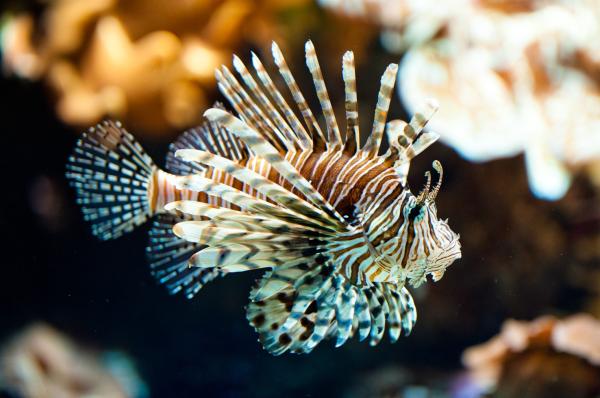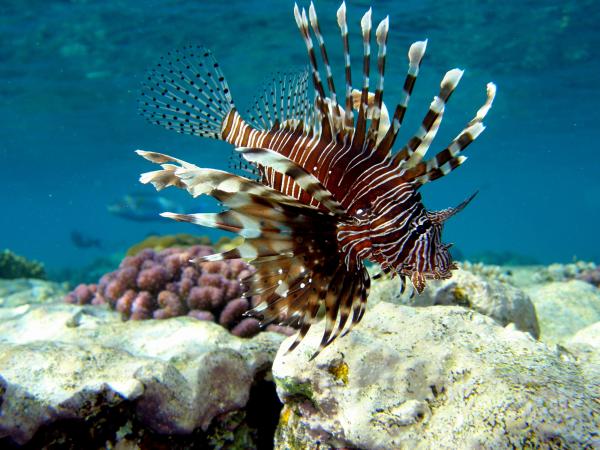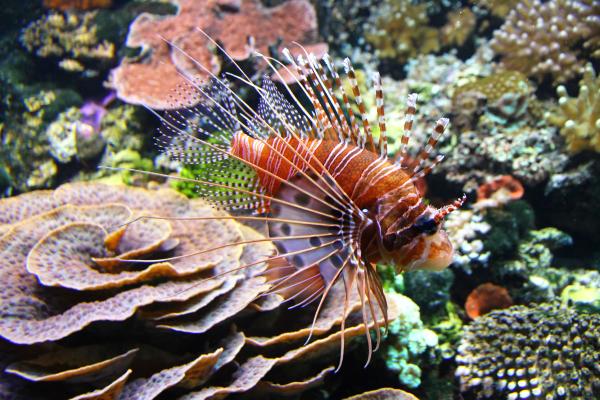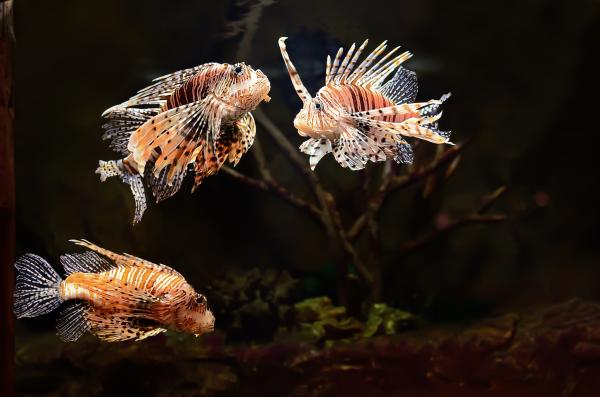The lionfish (Pterois genus) is one of the world’s most famous invasive fish, renowned for its striking appearance and powerful venom. In recent decades, lionfish have rapidly spread through the Atlantic and Caribbean, where they pose a significant threat to native marine ecosystems. This comprehensive guide covers lionfish species, physical traits, habitat, feeding habits, toxicity, and ecological impact—helping you fully understand this "underwater predator."

Lionfish belong to the family Scorpaenidae and genus Pterois. Their dramatic look makes them easy to recognize:
Fins: Lionfish have long, feather-like pectoral and dorsal fin rays, with extended, separated spines that resemble a lion’s mane—hence the name "lionfish."
“Horns”: Two fleshy appendages, resembling horns or antennae, extend above their prominent eyes.
Coloration: Lionfish display an aposematic (warning) pattern of alternating brown and white stripes. This not only serves as a beautiful display but warns predators of their dangerous venom.
Red Lionfish (Pterois volitans): Grows up to 35 cm; flowing, showy pectoral fins. The main invasive species in the Atlantic and Caribbean.
Clearfin Lionfish (Pterois radiata): Up to 25 cm; darker body, strikingly white pectoral fin rays, and white-pink barbels on the chin.
Miles’ Lionfish (Pterois miles): More rounded head and paler coloration, found mainly in the Indian Ocean.
Fact: There are 12 recognized lionfish species worldwide, each with slight differences in appearance and distribution.

Lionfish are benthic fish—meaning they live near the seafloor—typically inhabiting coral reefs, rocky outcrops, and seagrass beds.
Native Range: Indo-Pacific and western Pacific Oceans (Southeast Asia, Australia, etc.).
Invasive Range: Atlantic Ocean (especially the US East Coast, Caribbean, Mediterranean). Lionfish are now commonly spotted in Florida, the Caribbean, the Mediterranean, and off the coast of Venezuela. The invasion began largely due to aquarium releases.
Their striped coloration provides camouflage, helping them blend into complex reef environments and ambush prey.
Lionfish are carnivorous, nocturnal predators that feed on a wide variety of smaller fish (including guppies), shrimp, and crabs.
Hunting Behavior: They often lie in wait, drifting with the current before ambushing prey. Some lionfish will even hunt in groups to corner fish.
Cannibalism: Rarely, lionfish may exhibit cannibalistic behavior.
Feeding Impact: Invasive populations decimate native fish populations, outcompeting local species for food and space.

Yes, lionfish are highly venomous.
Venom Mechanism: Venom glands are connected to dorsal, anal, and pelvic fin spines. When threatened, lionfish flare their fins, exposing the spines as a defensive display.
Symptoms: Stings cause severe pain, swelling, fever, and in rare cases, breathing or circulatory distress.
First Aid: Immediately immerse the wound in hot water (40-45°C / 104-113°F) to reduce pain and neutralize some toxins, then seek prompt medical attention.
Lethality: While rarely fatal to healthy adults, lionfish stings can be dangerous for children or the immunocompromised, especially if stung underwater.
Note: Lionfish venom is not present in their flesh, so their meat is safe to eat if properly prepared.
Lionfish are considered the “kings of marine invasives” due to their adaptability, rapid reproduction, and lack of natural predators in non-native habitats.
Predatory Pressure: A single adult lionfish can consume over 4.7 kg (10 lbs) of prey fish per year, leading to steep declines in native fish populations.
Disrupted Food Webs: With fewer native fish, coral reefs suffer, and the balance of entire marine ecosystems can be destabilized.
Population Booms: In some places, like San Andres Island (Colombia), lionfish populations have reached over one million individuals, causing severe ecological disruption.
Economic Impact: The decline in native fish can harm commercial fisheries and local economies.

Lionfish are edible—their flesh is mild, tasty, and toxin-free when filleted. Promoting the harvest and consumption of lionfish is one of the most effective management strategies in invaded regions.
Conservation Benefit: Eating lionfish helps reduce their numbers and protect native ecosystems.
Caution: Harvest should target invasive regions only, to avoid impacting native populations in their natural range.
With their dazzling appearance and fearsome reputation, lionfish are both prized aquarium fish and formidable marine invaders. Combating their spread requires scientific monitoring, public awareness, and proactive removal—sometimes even encouraging people to eat them!
For ocean health, learning to recognize, report, and control lionfish populations is a vital step.
Bibliography
Sandford, G. (1994) The Complete Book of Aquarium Fish: A Complete Guide to Identifying, Selecting, and Maintaining Freshwater and Marine Species. Madrid: Tursen/Hermann Blume Ediciones.
Campos, N. & Acero, A. (2019) Marine Sciences. San Andrés: National University of Colombia.
Sánchez, J. (2021) Why Do We Depend on Biodiversity? Bogotá: Universidad de los Andes.
animal tags: Lionfish
We created this article in conjunction with AI technology, then made sure it was fact-checked and edited by a Animals Top editor.